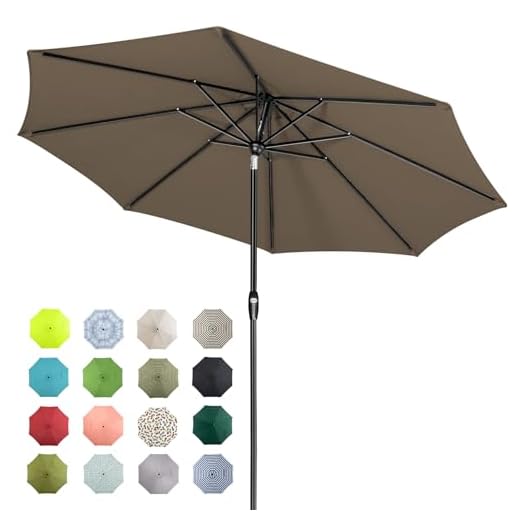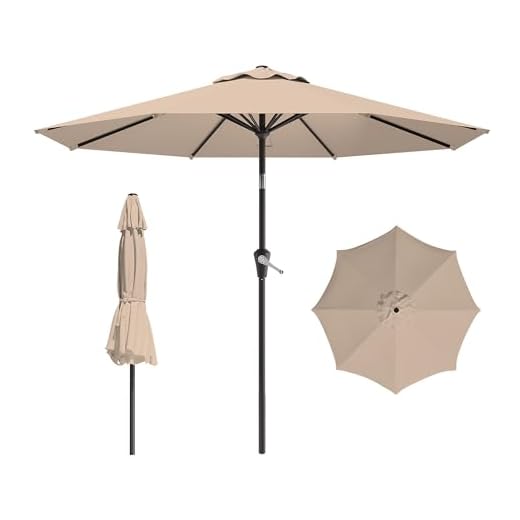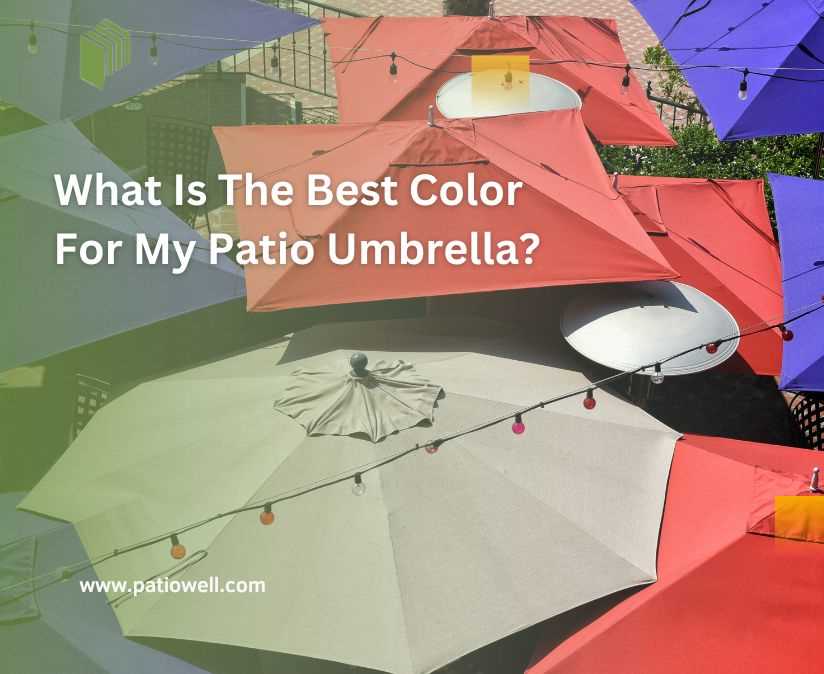




Opt for neutral shades such as beige or taupe for a classic and timeless look that complements various outdoor settings. These hues not only blend seamlessly with nature but also reflect sunlight effectively, keeping the area cooler.
This article provides insights into selecting the ideal tint for your patio cover, focusing on aesthetics, functionality, and personal preference. It will assist homeowners, event planners, and outdoor enthusiasts in making informed decisions that enhance their outdoor spaces.
We explore various tones, including vibrant options like deep blue and rich green, which add a pop of color while providing a contrasting backdrop against greenery. Additionally, we discuss the practical aspects of light absorption and fade resistance, ensuring longevity and maintaining visual appeal throughout the seasons.
Choosing the Right Shade for Your Patio Cover
Opting for a light hue can significantly enhance comfort by reflecting sunlight, keeping the area cooler. Shades like beige or soft pastels work well in sunny environments, minimizing heat absorption and providing a pleasant space for relaxation.
On the contrary, darker tones such as navy blue or deep green can create a striking visual impact while offering a cozy atmosphere. However, these shades may absorb more heat, potentially raising temperatures underneath the structure.
Factors to Consider
When selecting a tint, consider the following:
- Climate: In hotter regions, lighter shades may be preferable for their reflective properties.
- Style: Choose a tint that complements the overall aesthetic of your outdoor area.
- Maintenance: Lighter shades may show dirt more easily, requiring more frequent cleaning.
- Durability: Some pigments fade faster under intense sunlight; select fade-resistant options.
Ultimately, the choice of tone can influence not only aesthetics but also functionality, affecting temperature regulation and maintenance needs.
Impact of Color on Heat Absorption
Selecting a shade for a patio canopy can significantly affect temperature regulation in outdoor environments. Lighter tones such as white or beige reflect sunlight, keeping the area cooler. In contrast, darker hues like navy or charcoal tend to absorb heat, resulting in a warmer space underneath.
The mechanism of heat absorption is rooted in the physics of light. Light colors reflect a higher percentage of sunlight, while darker shades capture more energy. This can influence comfort levels during sunny days, making lighter options preferable for those seeking shade.
Heat Absorption Dynamics
The following factors can influence the degree of heat absorption:
- Reflectivity: Light colors reflect more sunlight, reducing heat accumulation.
- Material: Fabric composition can affect thermal properties, with some materials providing better insulation than others.
- Environmental Conditions: Humidity and wind can alter how heat is experienced in shaded areas.
Choosing a lighter tone can enhance comfort, especially in regions with intense sunlight. It is advisable to consider the local climate and usage patterns when selecting a suitable shade. This approach ensures a pleasant atmosphere while maximizing the benefits of outdoor spaces.
Choosing Shades Based on Your Outdoor Environment
Selecting the perfect hue for your patio cover involves more than just personal taste; it requires a keen understanding of your surroundings. Light tones, such as whites and pastels, can reflect sunlight and create a bright, airy atmosphere. These shades are ideal for areas with abundant sunlight, minimizing heat absorption and keeping the space cooler.
In contrast, darker shades like navy or charcoal absorb heat and can provide a cozy feel. These tones work well in shaded areas or places that experience cooler temperatures, helping to create a warm and inviting environment. The choice of tint can significantly influence your comfort and enjoyment outdoors.
Environmental Considerations
When deciding on a hue, consider the natural elements present in your vicinity. If your outdoor space is surrounded by lush greenery, earthy tones such as olive or muted browns can complement the foliage beautifully.
- Urban Settings: Bright or bold shades can stand out against concrete and steel, adding vibrancy to your space.
- Coastal Areas: Soft blues and sandy beiges can enhance the serene beach vibe and reflect the natural colors of the ocean.
Additionally, think about the materials and finishes of your furniture and decor. A harmonious palette can create a cohesive look, enhancing the overall aesthetic of your patio area.
Assessing how your chosen tint interacts with light throughout the day is crucial. Some shades may appear differently in the morning compared to mid-afternoon. The time of day can alter the appearance of the hue, impacting how it feels to be in that space.
In summary, aligning your selection with the surrounding environment not only enhances visual appeal but also improves comfort and usability. Choose wisely to create a space that invites relaxation and enjoyment.
Popular Color Trends for Patio Umbrellas
Choosing the right shade for a patio sunshade can significantly enhance outdoor spaces. Recent trends show a shift towards earthy tones and muted palettes, which blend seamlessly with nature while providing a calming atmosphere.
While traditional hues like navy blue and classic red remain popular, there is a growing preference for softer shades such as sage green and terracotta. These colors not only create a serene environment but also complement a variety of outdoor furniture styles.
Current Favorites
- Pastels: Light pinks, soft blues, and pale yellows are trending, offering a fresh and inviting look.
- Neutrals: Shades like beige, taupe, and gray are favored for their versatility and ability to blend with any decor.
- Bold Accents: Deep colors like burgundy or emerald serve as striking focal points, adding drama to outdoor settings.
Additionally, patterns are making a comeback, with stripes and geometric designs adding visual interest. These options allow for personal expression while maintaining a cohesive look with surrounding elements.
When selecting a hue, consider the overall ambiance you wish to create. Darker shades may provide a more intimate feel, while lighter options can open up the space and make it feel airy.
Maintenance Considerations for Different Umbrella Shades
Choosing a hue for your patio cover impacts not just aesthetics but also upkeep. Lighter shades tend to show dirt and stains more readily, requiring frequent cleaning to maintain their appearance. Darker tones, while stylish, can absorb heat, leading to potential fading over time.
Regular care is crucial, regardless of the tint selected. Here are specific tips tailored to various shades:
- Light Colors:
- Clean with mild soap and water bi-weekly.
- Use a UV protectant spray to minimize fading.
- Dark Tones:
- Inspect for signs of fading every month.
- Store indoors during extreme weather to prolong life.
- Bright Hues:
- Rinse after heavy rain to prevent water spots.
- Consider a protective cover when not in use.
- Neutral Shades:
- Regularly check for mildew and treat promptly.
- Wash with a solution specifically designed for outdoor fabrics.
Ultimately, mindful maintenance practices tailored to the specific pigment can significantly enhance the longevity and appearance of your outdoor shade solution.
Best color for outside umbrella
Features
| Color | Taupe |
| Size | 9FT |
Features
| Color | Beige |
| Size | 9FT |
Features
| Part Number | 9ftrust |
| Color | Rust |
| Size | 9 feet diameter, 54-60 inches pole length |
Features
| Color | Pink |
| Size | 7.5FT |
Video:
FAQ:
What color should I choose for my outdoor umbrella if I want to keep my patio cool?
Light colors, such as white, beige, or pastel shades, are ideal for outdoor umbrellas if you’re looking to maintain a cooler environment. These colors reflect sunlight rather than absorb it, helping to reduce heat underneath the umbrella. Additionally, light colors can create a more open and airy feel on your patio, making it a more pleasant space to relax during hot days.
Are there specific colors that fade less in the sun for outdoor umbrellas?
Yes, darker colors tend to fade faster than lighter ones when exposed to direct sunlight for prolonged periods. However, some manufacturers offer UV-resistant fabrics that help mitigate fading. Look for colors like navy blue, deep green, or maroon that are treated for UV protection. It’s a good idea to research brands that use high-quality materials designed to withstand sun exposure, ensuring your umbrella maintains its appearance over time.
How do I choose an umbrella color that matches my outdoor furniture?
To match your outdoor furniture, consider the existing color palette and style. If your furniture features bright or bold colors, a neutral umbrella color like gray, taupe, or white can balance the look. Alternatively, if your furniture is more subdued, choosing an umbrella in a complementary color can add an appealing contrast. Pay attention to patterns as well; if your furniture has intricate designs, a solid umbrella can provide a nice visual break.
What colors are best for outdoor umbrellas in rainy climates?
In rainy climates, it’s beneficial to choose colors that show less dirt and water stains. Darker shades, such as charcoal or forest green, can be practical as they tend to hide stains better than lighter colors. Additionally, consider materials that are water-resistant and quick-drying, which will help maintain the umbrella’s appearance after rainy weather. If you’re concerned about mold and mildew, ensure the fabric is treated for water resistance and easy cleaning.






